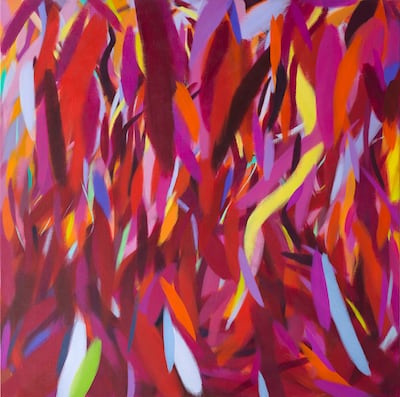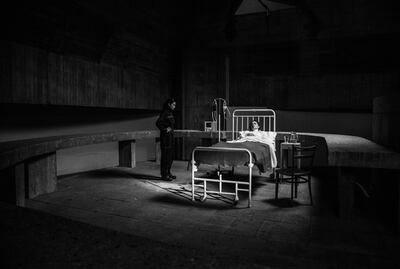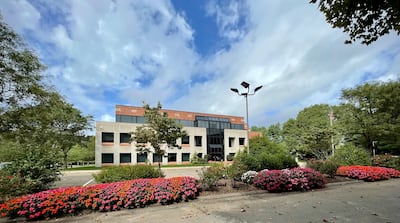While there may not be a Palestine Pavilion at the Venice Biennale, over the years, many artists and curators have worked — at times, despite controversy or censorship — to establish a Palestinian presence at the world’s biggest art event.
For the 59th International Art Exhibition, which runs from April to November this year, the Palestine Museum US will continue these efforts through a show dedicated to Palestinian art and artists. Based in Connecticut, the museum is a non-profit organisation centred on showcasing art by Palestinians from within the territories and the diaspora.
Titled From Palestine with Art, the exhibition will feature works by 19 artists, some of whom continue to live in the country, in cities and towns such as Gaza, Haifa, Ramallah, Bethlehem and Jerusalem. Other artists live in the US, Jordan and Kuwait.
Notable names such as Samia Halaby and Nabil Anani are among the participating artists, some of whom will be presenting new works specifically for the event. Set to open at a 560-square-foot space in the Palazzo Mora, the exhibition will showcase paintings, photography, sculpture and installations, with a historic map of Palestine covering the gallery floor and an olive tree standing in the centre.
In addition, elements of Palestinian cultural heritage, such as embroidery, recorded music and oral histories, will also be on display.

“Our mission is not political,” Palestine Museum US founder Faisal Saleh says. “It’s a humanising effort. I wanted to create a museum that will showcase Palestinian artistic excellence and provide a voice for Palestinians to speak with, through the arts,” he explains.
He established the museum in 2018 after living in the US for nearly five decades as a businessman. “At some point, I realised I really haven’t done anything for Palestine,” he says. “I became very interested in contributing to the Palestinian cause and people, my people.”
Since its opening, the Palestine Museum US has put together a programme of exhibits, artist talks and workshops, including a recent show on art and poetry. Saleh works with the museum’s head curator Nancy Nesvet to organise the exhibitions, including the coming show in Venice.
He is keen on bringing more Palestinian artists into the international art scene. “We expect that Palestinian art will receive a boost once after the Venice Biennale and that collectors will be seeking out more Palestinian artists,” Saleh says.
From Palestine with Art has been selected as one of the biennale’s official collateral events, a name for projects and exhibitions that have been admitted into the programming by the art biennial’s curator, Cecilia Alemani.
It is part of a long line of projects and initiatives around Palestinian art at the Biennale. In 2009, the ground-breaking exhibition Palestine c/o Venice became the first collateral event on Palestinian art to showcase at the Biennale since its establishment in 1895.
Curated by Salwa Mikdadi, it explored what she called “chronic impermanence” and how Palestinian art practitioners wrestled with representation and essentialism in media. “It felt important to have official representation because Palestine is not recognised as a nation state [by the Italian government] and cannot have a national pavilion at the Biennale,” she recalls.
An expert in modern and contemporary Arab art history and a professor at NYU Abu Dhabi, Mikdadi brought together artists Alessandro Petti, Emily Jacir, Jawad Al Malhi, Khalil Rabah, Sandi Hilal, Shadi Habib Allah and Taysir Batniji for the show.
“The core idea of the exhibition was to look at how artists responded to their environment and towards their own government bodies as citizens, not necessarily a response to the Apartheid Wall,” she explains. “We have the right to think beyond Israeli actions, and I wanted to see what the artists are working on within their own communities.”
In addition, she also co-ordinated with five Palestinian institutions to showcase duplicates of the artworks in Palestine.
Back in 2003, Francesco Bonami, the curator for the 50th Biennale, proposed the inclusion of a Palestinian Pavilion to the board. He was met with criticism and claims of anti-Semitism in a local Venetian newspaper the next day.
Times have changed since then, and curators and artists have continually carved out paths for Palestinian art to find a place within the international art scene. Among them are Bashir Makhoul and Aissa Deebi, who exhibited their works at the 55th Biennale in 2013 with the support of The Palestinian Art Court – Al Hoash, The Mosaic Room sand AM Qattan Foundation.
More recently, Larissa Sansour represented Palestine in the Danish Pavilion in 2019 and architects Elias and Yousef Anastas, founders of the architectural firm Aau Anastas, presented their work All Purpose at the Venice Architecture Biennale last year.

Mikdadi believes that the significance of national pavilions will continue to wane over the years, as notions of state representation become more nuanced and layered in a globalised world. Instead, the focus will be on the artists and their ideas rather than the nations they belong to. “I see more Palestinian artists exhibiting alongside international artists. These national pavilions will slowly disappear, and even now there’s a bigger emphasis on the curated exhibition at the Arsenale,” she says.
Now in 2022, From Palestine with Art includes a list of established and emerging practitioners, from Mohammed Alhaj, Sana Farah Bishara, Rania Matar, Mohamed Khalil and Nameer Qassim to Ghassan Abulaban, Jacqueline Bejani, Ibrahim Alazza and Hanan Awad, among others.
Influenced perhaps by his business background, one of Saleh’s goals behind the museum and its initiatives is to grow the market for Palestinian art. “Many Palestinian artists live under severe economic conditions, particularly the ones in Gaza and the West Bank. Their ability to sell work periodically is very important to them, so the museum would like to be of help to them,” he says, also specifying that the museum will not seek commissions and maintain its status as a non-profit.

Collateral events at the Venice show do not get funding support from Biennale organisers, so the Palestine Museum US is currently raising funds of $280,000 from private donors to bring the show to Italy. A number of canvasses are already on the way, and Saleh and Nesvet will be travelling to Venice for the installation.
Palestinian art exists as a form of active and creative resistance. For Saleh, he hopes that the show at the Biennale will allow the art to stand on its own merits and aesthetics, a shared aim with Palestine c/o Venice.
“There are a lot of people doing the political work, but our mission is to showcase Palestinian artwork in the front of the world. We want to tell the Palestinian story through the arts, which is an effective medium of communication rather than political wrangling,” Saleh explains.
“Palestinian artists are producing excellent work under severe conditions, including bombings … We want to have the artwork speak, just like any other work from elsewhere. We Palestinians are humans, just like everyone else. We have artists, poets, writers. We’re no different. We’re humans, entitled to human rights and ought to be treated with humanity. We’re crying out to the world to recognise that,” he says.






